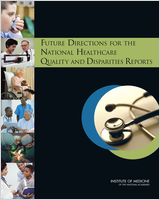NCBI Bookshelf. A service of the National Library of Medicine, National Institutes of Health.
Institute of Medicine (US) Committee on Future Directions for the National Healthcare Quality and Disparities Reports; Ulmer C, Bruno M, Burke S, editors. Future Directions for the National Healthcare Quality and Disparities Reports. Washington (DC): National Academies Press (US); 2010.

Future Directions for the National Healthcare Quality and Disparities Reports.
Show detailsWhen Congress mandated the production of the national healthcare reports in 1999, it did not provide dedicated funding to the Agency for Healthcare Research and Quality (AHRQ) for this purpose. Currently, the report-related effort is funded within AHRQ at an annual cost of approximately $3.7-$4.0 million. The Future Directions committee has recommended numerous improvements to the NHQR, NHDR, and their related products. The committee is cognizant of federal fiscal restraint and exercised diligence when weighing recommendations that would require additional funding. The committee concluded, however, that monitoring health care quality and disparities is an essential part of improving the nation’s health care system, and that such monitoring should be done well. Therefore, the committee recommends (in Chapter 7) that although some of its recommendations can be implemented with existing funds, additional funds are needed to support the expanded activities in this report. Although the committee was not tasked with providing specific budgetary amounts, in this appendix, the committee provides one illustrative example of how its recommendations might be funded.
To implement the improvements for the NHQR, NHDR, and related products, the committee’s illustrative funding scenario proposes a $5.5 million increase in AHRQ funds (Table I-1). The committee recognizes that this would be a substantial increase over current funding, but discusses how this increase would be used to transform the report products, engage national and state policy makers and other actors, strengthen performance metrics, improve data, and support the processes the committee has described.
TABLE I-1
Example of New Funding for AHRQ Related to the National Healthcare Report Endeavor.
The committee provides this estimate to convey the scale of the overall increase thought necessary. The committee developed this estimate by considering the major tasks to be accomplished and assessing the potential costs based on AHRQ’s current expenditures and the committee’s own experience with activities of a similar scope. An increase of this amount would give AHRQ a total budget of approximately $9.5 million for report-related activities. In the FY 2009 omnibus appropriations bill, AHRQ’s budget was $372 million, and the request for AHRQ in FY 2010 is the same. Thus, an increase in funding for AHRQ of this amount represents about a 1.5 percent increase in the overall AHRQ budget.
The speed of implementation will determine if all funds enumerated in the proposed example would be required in the initial year, and progress on activities thereafter would determine whether each increase would be required annually and indefinitely. As an example, the National Advisory Council for Healthcare Research and Quality (NAC) Technical Advisory Subcommittee for Measure Selection might complete the bulk of the prioritization analyses on measures within a couple of years calling for less frequent meetings and/or the sub committee may benefit from prioritization analyses conducted by other funded groups such as the National Quality Forum and thus may require less funding to contract for services.
In calendar year 2010, with a modest increase in staffing and resources ($750,000), AHRQ could include numerous upgrades in the 2010 NHQR, NHDR, and State Snapshots (which would be released in early 2011). While a major portion of this may go toward reconfiguring the reports themselves in the initial year, in subsequent years, a greater portion would be available for data acquisition and analysis, including substate analyses and more in-depth analyses related to priority populations. AHRQ at present spends about $1.6 million of its $3.7-$4.0 million budget on data acquisition and analysis.1 Another $1.25 million may be required for upgrades to Web-based resources, additional products, and enhanced dissemination activities.
It is estimated that $1 million would be required to staff the Technical Advisory Subcommittee for Measure Selection within the existing structure of AHRQ’s NAC. As indicated in Chapter 7, this technical advisory subcommittee should be established in calendar year 2010 to begin planning for the assessment of measures. In addition, AHRQ may need additional funds ($1 million) specifically dedicated to hiring staff or for contracting for the systematic review and analyses required to apply quantitative techniques to assess how much closing gaps in performance would benefit the overall health of the nation and of specific population groups. Funds should be dedicated to measure and data source development; the $1 million suggested is a relatively small investment given the costs of developing data systems, and the committee discusses in Chapter 7 the need for multiple partners to support the development of the health care data infrastructure. Finally, $500,000 may be needed by AHRQ to ensure an adequate evaluation of report-related efforts.
Footnotes
- 1
Personal communication, Ernest Moy, Agency for Healthcare Research and Quality, November 8, 2009.
- An Illustrative Funding Example - Future Directions for the National Healthcare ...An Illustrative Funding Example - Future Directions for the National Healthcare Quality and Disparities Reports
Your browsing activity is empty.
Activity recording is turned off.
See more...